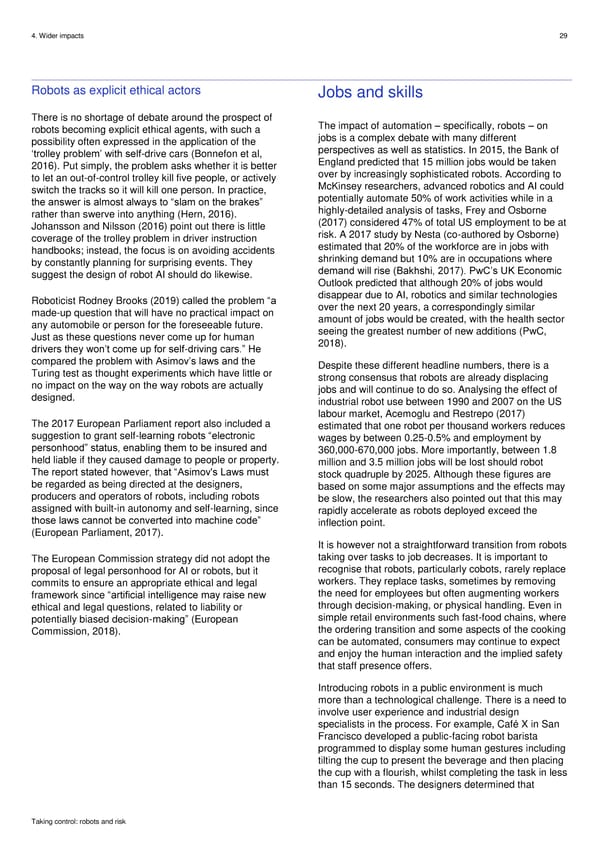4. Wider impacts 29 Robots as explicit ethical actors Jobs and skills There is no shortage of debate around the prospect of The impact of automation – specifically, robots – on robots becoming explicit ethical agents, with such a jobs is a complex debate with many different possibility often expressed in the application of the perspectives as well as statistics. In 2015, the Bank of ‘trolley problem’ with self-drive cars (Bonnefon et al, England predicted that 15 million jobs would be taken 2016). Put simply, the problem asks whether it is better over by increasingly sophisticated robots. According to to let an out-of-control trolley kill five people, or actively McKinsey researchers, advanced robotics and AI could switch the tracks so it will kill one person. In practice, potentially automate 50% of work activities while in a the answer is almost always to “slam on the brakes” highly-detailed analysis of tasks, Frey and Osborne rather than swerve into anything (Hern, 2016). (2017) considered 47% of total US employment to be at Johansson and Nilsson (2016) point out there is little risk. A 2017 study by Nesta (co-authored by Osborne) coverage of the trolley problem in driver instruction estimated that 20% of the workforce are in jobs with handbooks; instead, the focus is on avoiding accidents shrinking demand but 10% are in occupations where by constantly planning for surprising events. They suggest the design of robot AI should do likewise. demand will rise (Bakhshi, 2017). PwC’s UK Economic Outlook predicted that although 20% of jobs would Roboticist Rodney Brooks (2019) called the problem “a disappear due to AI, robotics and similar technologies made-up question that will have no practical impact on over the next 20 years, a correspondingly similar any automobile or person for the foreseeable future. amount of jobs would be created, with the health sector Just as these questions never come up for human seeing the greatest number of new additions (PwC, drivers they won’t come up for self-driving cars.” He 2018). compared the problem with Asimov’s laws and the Despite these different headline numbers, there is a Turing test as thought experiments which have little or strong consensus that robots are already displacing no impact on the way on the way robots are actually jobs and will continue to do so. Analysing the effect of designed. industrial robot use between 1990 and 2007 on the US The 2017 European Parliament report also included a labour market, Acemoglu and Restrepo (2017) suggestion to grant self-learning robots “electronic estimated that one robot per thousand workers reduces wages by between 0.25-0.5% and employment by personhood” status, enabling them to be insured and 360,000-670,000 jobs. More importantly, between 1.8 held liable if they caused damage to people or property. million and 3.5 million jobs will be lost should robot The report stated however, that “Asimov's Laws must stock quadruple by 2025. Although these figures are be regarded as being directed at the designers, based on some major assumptions and the effects may producers and operators of robots, including robots be slow, the researchers also pointed out that this may assigned with built-in autonomy and self-learning, since rapidly accelerate as robots deployed exceed the those laws cannot be converted into machine code” inflection point. (European Parliament, 2017). It is however not a straightforward transition from robots The European Commission strategy did not adopt the taking over tasks to job decreases. It is important to proposal of legal personhood for AI or robots, but it recognise that robots, particularly cobots, rarely replace commits to ensure an appropriate ethical and legal workers. They replace tasks, sometimes by removing framework since “artificial intelligence may raise new the need for employees but often augmenting workers ethical and legal questions, related to liability or through decision-making, or physical handling. Even in potentially biased decision-making” (European simple retail environments such fast-food chains, where Commission, 2018). the ordering transition and some aspects of the cooking can be automated, consumers may continue to expect and enjoy the human interaction and the implied safety that staff presence offers. Introducing robots in a public environment is much more than a technological challenge. There is a need to involve user experience and industrial design specialists in the process. For example, Café X in San Francisco developed a public-facing robot barista programmed to display some human gestures including tilting the cup to present the beverage and then placing the cup with a flourish, whilst completing the task in less than 15 seconds. The designers determined that Taking control: robots and risk
 Robots & Risk Page 28 Page 30
Robots & Risk Page 28 Page 30